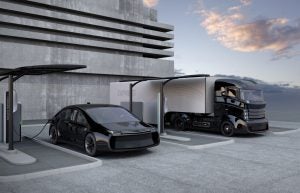After banner EV commitments at COP26, it’s time for U.S. to lead
 By Jason Mathers and Peter Zalzal
By Jason Mathers and Peter Zalzal
The global convening of international climate leaders at COP 26 delivered transformative commitments from countries and companies around the pace of transition to zero-emission vehicles. Leading automakers such as Ford, GM and Mercedes-Benz, as well as more than two dozen countries agreed that by 2035, all new cars sold should be zero-emission. Fifteen countries also agreed that the same should be achieved for trucks and buses by 2040.
It’s great to see global commitments to these targets (which EDF has previously called for), because transportation is the primary source of climate pollution and a leading cause of premature deaths around the world. However, missing from both of these historic agreements was the United States.
Americans deserve the health and economic benefits that achieving these targets would deliver. Given the long-lives of new vehicles, these targets are critical to achieving net-zero emissions by 2050.
Thankfully, it’s not too late for the U.S. to embrace these timeframes and support these goals with transformative, durable policy solutions.
The fine print
Ford embracing the 2035 timeframe for leading markets is particularly noteworthy. The company’s recent push into EVs has been well documented. It’s also a move that’s necessary to meet science-based climate commitments, and one that will grow jobs.
A recent analysis commissioned by EDF found that a single assembly plant with 3,300 direct jobs producing Ford’s electric F-Series trucks, including the F-150 Lightning, could support 44,000 American jobs and more than $5 billion of U.S. gross domestic product. Ford joined General Motors — which previously embraced the 2035 date — as well as several other automakers in the announcement, and over two dozen countries — including event host United Kingdom — in committing to this timeframe.
After banner EV commitments at COP26, it’s time for U.S. to lead Share on XFor heavy-duty trucks, 15 countries agreed to work together toward 100% zero-emission new truck and bus sales by 2040. This Global Memorandum of Understanding for Zero-Emission Medium- and Heavy-Duty Vehicles is similar to the U.S. regional MOU signed in 2020 by 15 states and D.C. to collaborate on the adoption of zero-emission trucks. The 2040 timeframe is crucial for speeding the transition to 100% zero-emission trucks and buses, which EDF and others have called for to address the climate and air quality crisis we currently face.
The global MOU also embraces an interim target of 30% zero-emission new vehicle sales by 2030, reflecting the urgent need to rapidly grow this market now from a small base.
As we have noted before, achieving this target is within our grasp. Getting there will require us to focus first on scaling production in the heavy-truck segments that are most ready to move to electrification — of which there are many: Local delivery vans, transit buses, school buses, box trucks and garbage trucks are among the vehicle types that can support widespread electrification between now and 2030.
An imperative to act
The environmental stakes for meeting the time frames outlined at COP26 are massive for the U.S. EDF analysis shows that eliminating pollution from all new freight trucks and buses no later than 2040 — and from freight trucks and buses used in urban and community areas no later than 2035 — would prevent 57,000 premature deaths and eliminate more than 4.7 billion metric tons of climate pollution by 2050.
The savings for passenger vehicles would be even more profound. EDF analysis on these vehicles found that ensuring all passenger vehicles sold by 2035 were zero-emission would eliminate more than 11.5 billion tons of climate pollution cumulatively and prevent as many as 98,000 premature deaths by 2050.
The Biden administration issued an executive order in August outlining steps for U.S. action to accelerate the adoption of zero-emission cars and trucks. To realize this vision, the administration should move forward with new emission standards that eliminate pollution from all new passenger cars by 2035 and all new freight trucks and buses by 2040. Congress needs to lead, too by enacting the critical electric vehicle provisions in the Build Back Better Act.
It’s disappointing that the U.S. missed an opportunity to join with other countries in these commitments at COP26 and firmly establish itself as a leader in the global transition to EVs. But America can continue to lead on zero-emission vehicles if it seizes this moment to support regulation and policy that will generate hundreds of thousands of high-quality jobs, improve air quality for all Americans and fight climate change.










